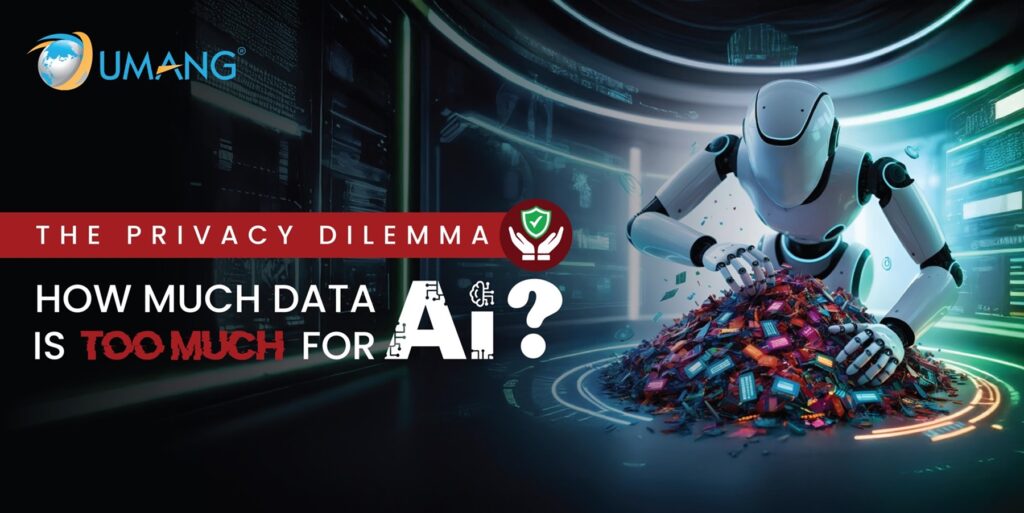The Privacy Dilemma: How Much Data is Too Much for AI?
In the age of Artificial Intelligence, data is the new oil. It powers everything from personalized ads and smart assistants to life-saving healthcare predictions. But there’s a growing concern echoing across boardrooms, bedrooms, and courtrooms alike: How much data is too much?
As AI becomes more integrated into our lives, the fine line between innovation and intrusion is getting harder to define.

1. Why AI Needs Data:
AI learns by analyzing massive datasets – think images, conversations, clicks, health records, GPS signals, and even facial expressions. The more data it gets, the better it performs.
-
A Virtual Assistant becomes more helpful the more it learns your voice.
-
A Healthcare AI can predict diseases better with access to complete patient histories.
-
A Smart City System can optimize traffic only if it knows where everyone’s going.
The problem? All of this data often comes from you – sometimes without you even knowing.
2. When Personalization Turns into Surveillance:
At its best, data-driven AI improves lives. But at its worst, it can feel like you’re being watched, judged, and nudged without consent.
Let’s break this down with real-world examples:
-
Social media algorithms track your every like, pause, and scroll to keep you hooked – at the cost of your attention and mental health.
-
Smart devices like TVs or voice assistants may “listen” continuously – even when they shouldn’t.
-
Health apps can collect sensitive biometrics and sell it to advertisers, sometimes buried deep in privacy policies.
In India, the Aarogya Setu app for COVID-19 contact tracing raised serious questions about consent, data retention, and transparency, even though it helped in pandemic management.
3. The Consent Confusion:
Ever noticed how you click “Agree” to terms and conditions without reading them? You’re not alone.
Informed consent is supposed to be the cornerstone of data privacy. But most users:
-
Don’t fully understand what they’re agreeing to
-
Can’t opt out without losing access
-
Aren’t told how long data will be stored or who it’s shared with
And in many regions – especially in developing countries – data literacy is low, making users more vulnerable.
4. The Global Push for Data Protection:
Governments are stepping up to protect citizens’ privacy:
-
EU’s GDPR (General Data Protection Regulation) enforces strict consent, data minimization, and the “right to be forgotten”.
-
India’s Digital Personal Data Protection Act (DPDP), 2023 is a step toward regulating how companies collect and store user data, but enforcement and awareness are key.
-
California’s CCPA gives users more control over how their data is sold or shared.
Yet, the pace of regulation often lags behind the speed of AI innovation.
5. So… How Much is Too Much:
It’s not just about how much data is collected, but:
-
Who is collecting it?
-
Why are they collecting it?
-
Can you revoke consent later?
-
What happens if the data gets leaked or misused?
In short: Enough is enough when it compromises autonomy, security, and trust.
The Way Forward: Responsible AI + Empowered Users
We can’t stop AI from evolving – but we can shape how it interacts with our lives.
Here’s what needs to happen:
a. Transparency by Design
Companies must clearly state:
-
What data they’re collecting
-
How it’s being used
-
How users can opt out
b. Privacy-Centric AI
AI models can be trained using:
-
Synthetic data (fake but statistically similar)
-
Federated learning (where data stays on your device)
-
Differential privacy (adding noise to protect individuals)
c. User Education
Empowering users with digital literacy is crucial. People should understand their data rights – especially in countries like India, where mobile-first users are growing fast.
d. Stronger Regulation
Laws need to evolve with tech. Regulations should balance innovation with protection – and be enforceable across borders.
Final Thoughts
Data fuels the AI revolution, but privacy is not a luxury – it’s a right. The goal isn’t to shut down innovation but to build AI systems that respect boundaries and earn trust.
Because in the end, what’s the point of smart technology if it doesn’t make us feel safe?
